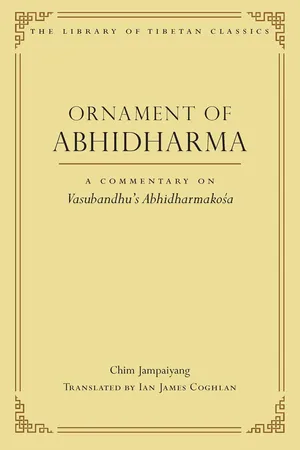![]()
![]()
2. Conditioned Phenomena
THE MEANING OF THE TEXT
There are eight parts. The first:
THE EXPOSITION OF THE ELEMENTS
This has three parts: core taxonomies of conditioned phenomena; synonyms; and elaboration of aggregates, bases, and elements.
Core taxonomies of conditioned phenomena
Also conditioned phenomena
are the five aggregates — form and so on.
They are the times, the basis of language,
definitely transcended, and they possess a basis. (1:7)
Question: What are those conditioned phenomena previously cited in the statement “Conditioned phenomena, except for the path, are contaminated” (1:4bc)?
Reply: {Conditioned phenomena are classified in five: the basis of classification, that which is classified, the number of those classified, the definite number of those classified, and the purpose of such classification.
THE BASIS ON WHICH CLASSIFICATION IS MADE
Engaging in the Deeds of a Bodhisattva states:
There is nothing anywhere
fabricated from a single condition.216
The Collection of Birth Stories says:
There is nothing anywhere
established from a single cause.217
Therefore conditioned phenomena arise due to the assembly and convergence of many causes and conditions, since they do not arise from a single cause or condition. Moreover, [Vasubandhu’s] Rational System of Exposition explains that dharma has ten meanings,218 and it is said in the Miscellaneous Discourses that anything that retains its characteristics is called a dharma. Therefore objects of knowledge (jñeya) that retain their characteristics are dharmas. “Also” (1:7a) indicates that not only do phenomena and unconditioned phenomena have classifications, but also conditioned phenomena have classifications.
THE THINGS THAT ARE CLASSIFIED
These are the aggregates of form, feeling, discernment, formation, and consciousness, which are differentiated from the liberated aggregates, such as the aggregate of ethics, and the five objects, such as form, because these latter categories do not include all conditioned phenomena. [27]
THE NUMBER OF THOSE CLASSIFIED
There are five.
THE SET NUMBER OF THOSE CLASSIFIED
They are definitely five in number because they are taught to be the bases grasped as “I” and “mine.” Childlike beings predominantly hold consciousness to be “I” and form and so on to be “mine.” Thus they think, respectively, that “external and internal material forms are related to the self who is the agent and object of actions; feeling is experienced by the self; discernment applies names by discriminating objects seen and heard and so on to be the self; and the mind grasping a self activates karmic formation that engages virtue and so on.” Thus these four are grasped as “mine.” The Great Treatise on Differentiation notes:
There are just five aggregates, neither more nor less, because they fully reveal the basis for grasping at “I” and “mine.” Childlike beings predominantly hold consciousness to be “I” and the remaining aggregates such as form to be “mine.”219
Also the Compendium of Abhidharma explains that the aggregates are fixed in number for a specific purpose when it reveals:
Five aggregates are taught in order to reveal the five bases that are held as the self.220
Again:
Conditioned phenomena are definitely twofold: form and that which is not form. That which is not form is definitely twofold: mind and that which is not mind. Conditioned phenomena that are neither form nor mind are definitely the three aggregates of feeling and so on.221
THE PURPOSE OF SUCH CLASSIFICATION
Question: Are the five aggregates different substances (dravya), are they synonyms, are they the same in nature but different conceptual isolates, or are they different distinct states?}
Reply: The form (rūpa) aggregate and so on — referring to feeling, discernment, formation, and consciousness — are the five aggregates (skandha). Conditioned phenomena (saṃskṛta) are created through the assembly and convergence of conditions, and there are none whatsoever that are produced from a single condition.
Question: But how can instances of future nonarising be called “conditioned phenomena”?
Reply: They are called “conditioned phenomena” because they are similar in kind and characteristics to arisen states. It is like the milk in an unmilked cow being called “milk” since it is similar to the milk from the udder.
“Also” teaches that not only are there classifications of unconditioned phenomena, but there are also classifications of conditioned phenomena. Stating “form and so on” and “aggregates” (1:7b) excludes liberated aggregates, such as the aggregate of ethics, and the external bases.
Question: Which of these aggregates are substantially the same? Which are different? Which are different distinct states? Which are synonyms?
Vaibhāṣikas assert that they are substantially distinct. For they assert that the form aggregate consists of coarse form and subtle particles, and they claim both are types of substance. They assert that feeling, discernment, associated formative factors, form, and mind are different and also internally differentiated. They say that nonassociated formative factors are things (bhāva) that are different from form, mind, and mental factors. Because consciousness is also different from the other aggregates, all five aggregates are substantially existent. Therefore the body of Devadatta is called “the aggregate of form” because it is an aggregate [28] as well as form, and as such, it comprises their common locus. This explanation also applies to the other aggregates.
Sautrāntikas assert form, feeling, discernment, associated formative factors, and consciousness to be substantially existent. Nonassociated formative factors are imputed in the context of form, mind, and mental factors, but they are not substantially existent. Particles and moments are substantially existent. But because gross entities and continua are not substantially existent, aggregates are nominally existent. Therefore, because form is substantially existent and aggregate is nominally existent, the form aggregate is a union of different components, like the various components of Devadatta. This should be applied in the same way to other instances.
Yogācāras assert that material form is not substantially different from minds or mental factors. They assert that the aggregates are nominally existent because nonassociated formative factors are not separate from them, and that continua are not substantially established.
Synonyms of “aggregates”
These are now stated since the Subcommentary declares:
Since Abhidharma in its entirety constitutes the meaning of the sūtras, resolves the sūtras, and explains the sūtras, the identity of the synonyms of the aggregates, such as “time” and so on, are expressed in the sūtras.222
Those conditioned phenomena are called “the three times” (adhvan) because those that have gone are past, those that are active are present, those that will come are future. So too, such conditioned phenomena are called the “basis of language” (kathāvastu) because discourse is {the sound of the letters themselves, or} speech.
Objection: Its basis is the names [or nouns] expressed, and only names are the basis of language.
Reply: That is not so because {all conditioned phenomena} are said to be the basis {of speech} and the basis {of language}. All conditioned phenomena are the basis of language because speech engages names, and those {names} express all conditioned phenomena. {Further, all conditioned phenomena are the basis of language since names are the explicit subject matter and their meaning is the conceived subject matter.} Although unconditioned phenomena are the subject matter of names, they are not taught to be the basis of language since they are not causes and since they are expressed less frequently. Thus Entering Discussion on the Abhidharma correctly affirms:
The basis of language is subsumed by the eighteen elements.223
Also, conditioned phenomena are “definitely transcended” (saniḥsāra) because definite transcendence is nirvāṇa, the misery definitely transcended is conditioned phenomena, and that which transcends misery is [29] that which is beyond conditioned phenomena.
Objection: Since the truth of path is not something you transcend, all conditioned states are not definitely transcended.
Reply: It is said in the Medium-Length Discourses:
If you abandon Dharma knowing it is like a ship which represents Dharma, then it goes without saying that you abandon that which is not Dharma.224
Ornament of the Mahāyāna Sūtras also maintains:
Through understanding that you have passed beyond saṃsāra,
you recognize all Dharma to be like a ship.225
Therefore, in entering nirvāṇa without remainder you definitely transcend conditioned phenomena.
Also, conditioned phenomena “possess a basis” (savastuka) because here basis is said to refer to “[those that possess] a cause.” These then are the synonyms of conditioned states.
In particular, regarding the synonyms of contaminated phenomena:
When they are contaminated, they are also
appropriated aggregates. They are also:
associated with conflict, suffering, origin, destructible,
the locus of view, and existence. (1:8)
When conditioned phenomena are contaminated (sāsravā), they are also appropriated aggregates (upādānaskandha). Appropriated means “afflicted,” and they are appropriated aggregates since they are derived from affliction, like a grass fire or straw fire.226 {Again, since they rely on appropriation, they a...



